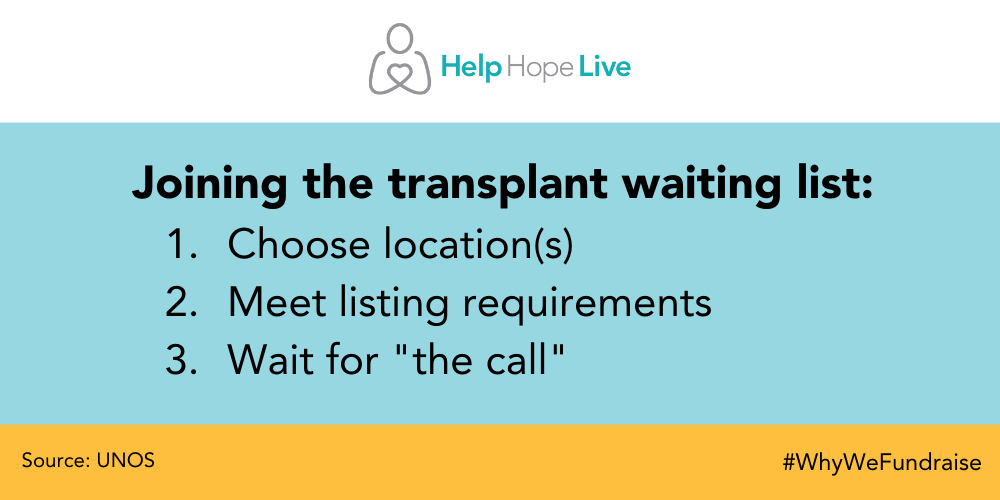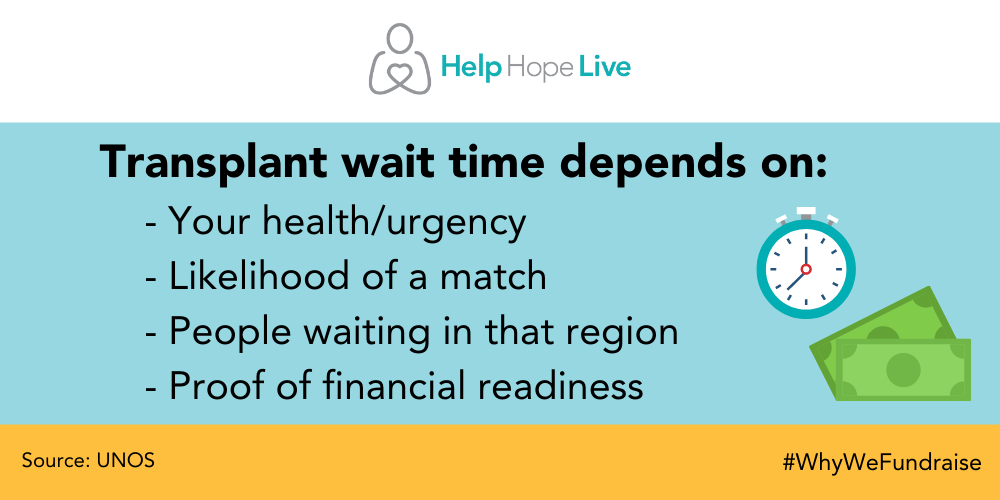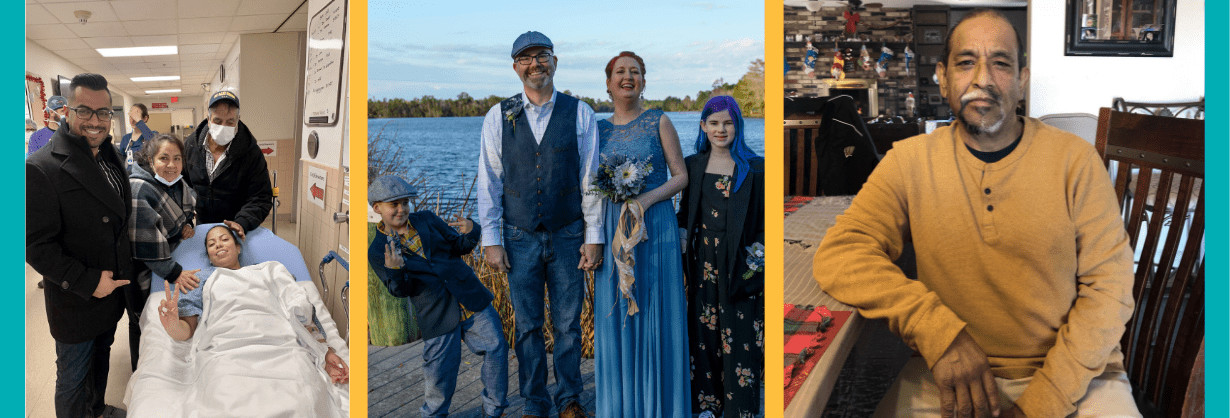This post was last updated in August 2025.
Whether you’re preparing for your first organ transplant or supporting a loved one who is starting a transplant journey, you might wonder how many people are waiting for organ transplants.
In this blog, we’ll explain how many people are currently on the transplant waiting list, how to get on the transplant waiting list, and how to find financial assistance for transplant patients.
How many people are waiting for an organ transplant right now?
According to organdonor.gov, there are currently 103,000 people waiting for organ transplants. That number includes both adults and children.
National data from OPTN gives us additional insights on the transplant waiting list:
- More than 80% of transplant candidates are waiting for a kidney transplant
- 10% of transplant candidates are waiting for a liver transplant
- 3% of transplant candidates are waiting for a heart transplant
- Less than 1% of transplant candidates are waiting for a lung transplant
- Less than 1% of transplant candidates are waiting for a pancreas transplant or a multi-visceral/intestine transplant
How old are the people on the transplant waiting list?
According to OPTN, about 47% of people on the transplant waiting list are between 50 and 64.
- 27% of people on the transplant waiting list are 65 or older
- 25% of people on the transplant waiting list are between 35 and 49
- 9% of people on the transplant waiting list are between 18 and 34
- 8% of the transplant waiting list is children under 17 years old
How long will someone be on the transplant waiting list before they get a transplant?
OPTN indicates that the median wait time for a transplant is between one year and two years. Here are the average waiting times for the most common transplant types, all impacted by multiple factors ranging from geography to diagnosis to availability:
- Kidney transplant candidates wait an average of one to five years for a transplant according to the National Kidney Foundation
- Liver transplant candidates wait between 30 days and five years for a transplant on average according to NIH
- Lung transplant candidates wait an average of three to six months for a transplant according to Cleveland Clinic
- Heart transplant candidates wait an average of one year for a transplant according to Temple Health
- Pancreas transplant candidates wait an average of two years for a transplant according to Mayo Clinic

Which state has the longest waiting list for a transplant?
Overall, California has the largest number of people waiting for a transplant with more than 21,700 people on the transplant waiting list.
Keep in mind that a large waiting list doesn’t automatically translate to a longer wait for a transplant—transplant rates depend on waiting list, organ availability, and the region’s transplant capabilities among other factors during the organ transplant process.

How many transplants happen in a year?
UNOS reports that there were over 48,000 transplants in 2024.
- 59% (24,669) were kidney transplants
- 22% (9,236) were liver transplants
- 9% (3,817) were heart transplants
Where Do Transplants Take Place Most Often?
OPTN reports that the most transplants in the country have taken place in:
- California (119,978 transplants since 1988)
- Texas (84,809 transplants since 1988)
- Pennsylvania (69,106 transplants since 1988), and
- New York (68,083 transplants since 1988)
Does race or ethnicity impact your time on the transplant waiting list?
In 2020, white patients were the largest percentage of the waiting list and the largest percentage of the transplants performed.
- White patients made up 40% of the transplant waiting list
- Black patients made up 28% of the transplant waiting list
- Hispanic patients made up 20% of the transplant waiting list
- Asian patients made up 8% of the transplant waiting list
- Other ethnicities made up 2.5% of the transplant waiting list
Of the patients who received a transplant in 2020:
- 53% were white
- 21% were black
- 5% were Hispanic
- 5% were Asian
- 2% were other ethnicities
What is the process for joinng the transplant waiting list?
According to UNOS, the typical process for joining the organ transplant waiting list list begins with your medical professional determining that you need a transplant and referring you to a transplant center or hospital.
As a transplant candidate, you may review your options for receiving a first organ transplant at multiple different centers (and in multiple states) before you choose a location. Your choice of location may depend on:
- Which transplant hospital is capable of performing that particular transplant surgery
- Whether your insurance covers some or most of the costs associated with a transplant at a particular transplant hospital
- The requirements that each hospital establishes for transplant eligibility and whether you meet those criteria
- The length of the transplant waiting list in a particular state or region
If you need to repeat the organ transplant process to receive another transplant in the future, you can choose to move forward with the same transplant hospital or select a new transplant hospital based on the transplant type, your medical needs, your physical location, eligibility requirements, or other factors.
If you are eligible to receive a transplant from a living donor, such as a kidney or partial liver transplant, you may be able to significantly shorten your wait time by asking friends and family members to get tested as potential living donors.
In some cases, you may be hospitalized as you wait for an organ to become available.

What Happens After a Patient Joins the Waiting List for a Transplant?
Once you join the waiting list for a deceased donor transplant, you will typically receive information on how long you can expect to wait for the transplant.
Living donor transplant candidates can join the waiting list for a deceased organ while their loved ones go through the testing process to potentially become a living donor.
If you are waiting for a deceased donor organ, you will be required to have a phone with you at all times in case “the call” comes through that an organ is available. When you receive “the call,” you will need to proceed to the transplant hospital as quickly as possible while the organ is still viable for initial testing to determine compatibility. Some of these calls may result in “dry runs,” during which you learn that the organ is not a fit for you.
Keep in mind that a transplant candidate can potentially join the waiting list in multiple states at once to try to shorten their wait for a transplant. This option relies on being able to rapidly travel to that location if you get “the call” that a suitable organ is available for you.
How does someone move up or down the transplant waiting list?
Your position on the transplant waiting list can be influenced by multiple factors.
Primarily, your position is determined by how rapidly and critically a transplant is needed to stabilize your health. A patient with a short timeframe for survival without a transplant will typically be placed higher on the transplant waiting list than a patient who may be able to survive for years without a transplant.
Keep in mind that you will not be eligible for a transplant if your health deteriorates to the point where your transplant team believes that the surgery will no longer serve as a safe or effective intervention. If this kind of health setback occurs, you may be removed from the transplant waiting list until certain health conditions are met.
An organ must be a match for a patient’s biology within certain parameters in order for the organ transplant process to proceed without triggering irreversible transplant rejection. You may have a shorter or longer wait based on whether your unique parameters are easier or more difficult to match with deceased or living donor organs compared to other patients.
Your position on the transplant waiting list will always be influenced in part by how many people are waiting for organ transplants in your region with a similar organ type need and their respective eligibilities to receive a transplant.
Keep in mind that proof of financial readiness is often a requirement to join the transplant waiting list.
If you are not able to provide proof of savings or transplant fundraising with your hospital, you may be removed from the transplant waiting list until you can show financial readiness for the anticipated out-of-pocket expenses associated with the procedure.
In some cases, your transplant team may share your position on the transplant waiting list with you to give you a better understanding of how long you may wait for a transplant.

How can transplant patients get financial assistance with transplant costs?

If you or a loved one need assistance preparing for the out-of-pocket cost of a transplant, our medical fundraising nonprofit can help. Here are the costs you can expect to encounter for each transplant type and how to find financial resources or start fundraising for a transplant:
Liver Transplant Financial Assistance
Heart Transplant Financial Assistance
Kidney Transplant Financial Assistance
Lung Transplant/Double Lung Transplant Financial Assistance
Pancreas Transplant Financial Assistance
Other Organ Transplant Financial Assistance
Our nonprofit has helped thousands of patients to receive life-changing transplants since we were founded in 1983 by a pioneering heart transplant surgeon and his wife, a nurse. Today, more than 6,000 medical professionals trust and recommend Help Hope Live as a transplant fundraising option.
Discover how we’re different from crowdfunding or submit a campaign request today to begin the transplant fundraising process.
Written by Emily Progin








